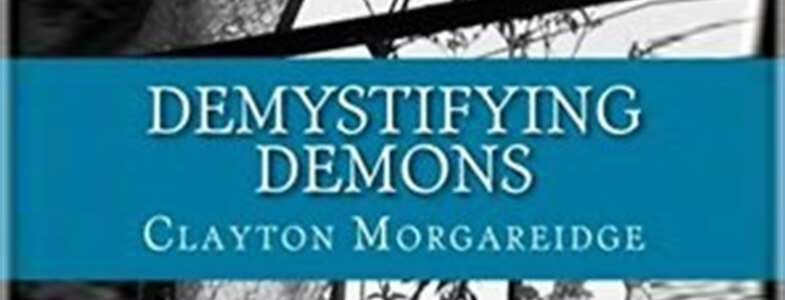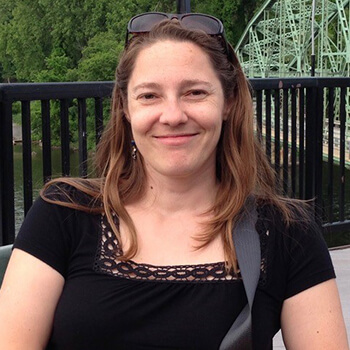Demystifying Demons: Rethinking Who And What We Are
By Clayton Morgareidge
Review by Monica Vilhauer
Demystifying Demons, by Clayton Morgareidge, introduces itself as a book for troubled souls. (I’m in!) With a philosophical and psychoanalytic orientation, but without the usual impenetrable language of texts in those disciplines (sigh of relief), it approaches the study of the soul in a refreshingly accessible and personal manner. It draws on struggles recognizable to us from movies, novels, song-lyrics, and even the author’s own life. As the author proclaims: “This is one troubled soul talking to another.” From my experience, reading it was much like a conversation with a wise and compassionate friend.
The author takes a secular approach to the topic of the soul and its demons. The soul is less of a religious or metaphysical concept for him, and more of a name that describes our inner life, or our “interior weather,” which is always in flux but not in total chaos. There are repeating patterns that most of us will recognize. Likewise, the mysterious “demons” we struggle with are not little children of Satan, but rather the storms and droughts of our interior weather, which keep returning in our lives, disturbing us, and challenging us.
By outlining the territory of the soul and its interior weather patterns, and by articulating the ways in which these patterns develop, the book offers insight into the origins of our most common types of soul-suffering, including guilt, anxiety, self-loathing, feeling like one is an imposter, and rage. The goal of the book is to shine a light on these dark, mysterious “demons” that torment us, in an attempt to make them a little less frightening, less tyrannical, and less debilitating (much like, as the author says, the effect of a nightlight on the monster under the bed). Illumination and clarification, then, are expected to have a therapeutic function in this work.
The book shines a helpful light on the following mysterious aspects of the life of the soul:
- The unconscious sphere, and the disturbing feelings and judgments that seem to rule in us as if they had a mind of their own.
- The social nature of the soul, and the roots of our “interior weather” in the ways significant others approach us, react to us, offer and deny us recognition, and expect things of us.
- The internalized voice of judgment (a.k.a. the voice of “the big Other”), which commands us from the perspective of real or imagined societal rules, and is particularly good at bullying us and producing feelings of fear, shame, humiliation, self-loathing, and resentment.
- The power of our pre-verbal experiences with our mother figures in forming our fundamental (healthy, problematic, or confused) orientations in the world.
- The inadequacies of our usual forms of “objective” language for expressing the depths of our ambiguous (physical-emotional-mental) experience, but also the special potential of the languages of art (especially poetry, music, and dance) for communicating and connecting with others beyond the boundaries of objective language.
- The universal nature of soul-struggles, and the way all of our lives are rooted in a variety of functional and dysfunctional relationships, with deep layers of experience unknown to ourselves and not fully under our own control.
With this final insight, the book inspires compassion for others and for ourselves, as we wrestle with the basic facts of our human condition. It also opens up new questions about what we can do for our healing. In the book, we discovered both the potential and the limitations of clarifying thought and talk-therapy for our healing. At a certain point, should we shift gears from books and counselors to art?! And finally, if compassion is an important element in our healing, what might a compassionate society look like? The author mentions the problems that a competitive capitalist society poses for the cultivation of compassion, love, solidarity, trust, cooperation, and mercy. Further, there is the voice of “the big Other,” which seems inevitable as long as we live in any kind of society, and which has a tendency to shout louder than compassion. How can we overcome the immense pressure of these two forces? Perhaps part of the answer (toward which I sense the author gestures), is to realize that they (these forces, these institutions, these norms) are our creations, and we as a culture can reform them.
Recommendation
The book is ideal as a companion to therapy. It is also a lovely invitation into philosophy and psychoanalysis for those who would like to understand their relevance for everyday life. It would work well in an introductory general studies course. For me, one of the most wonderful aspects of the book is the way it picks up on a very old tradition of philosophy, often forgotten in the modern version of the discipline, which aims to diminish suffering by way of clarifying the understanding and shifting our basic approach to the world, ourselves, and others for the better. I place the book in the tradition of philosophy as therapy, and not the self-help tradition, for several reasons. As the author admits (with a bit of a laugh, I imagine), it is “not relentlessly upbeat,” nor does it offer a quick-fix for our soul-struggles. It also does not try to conceal the “awesome complexity” of the soul, the ultimately tragic elements of human life, or the fact that we can never become fully transparent to ourselves. Yet, it is optimistic that we can make some progress in our understanding, we can ease some suffering, and it’s worth the effort to do both.
Find Demystifying Demons on Amazon.


